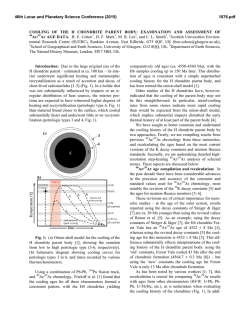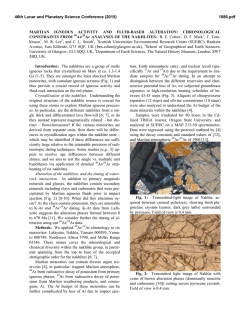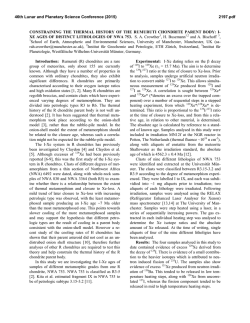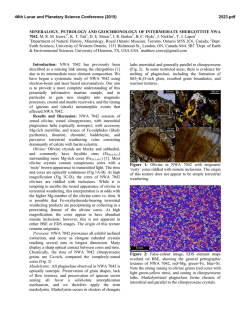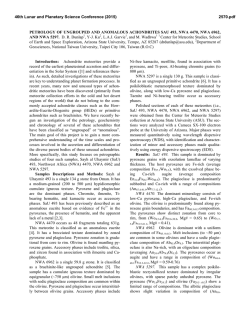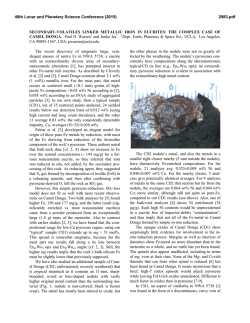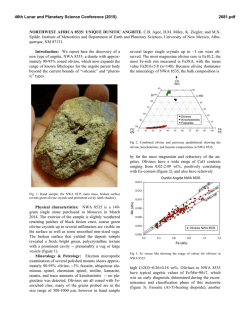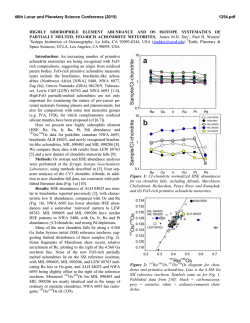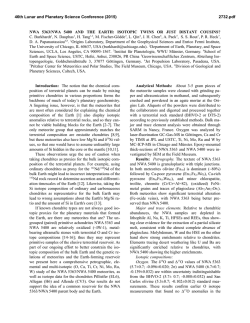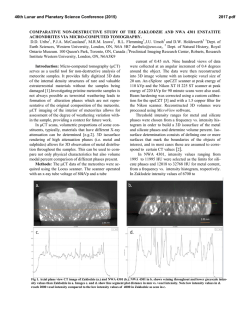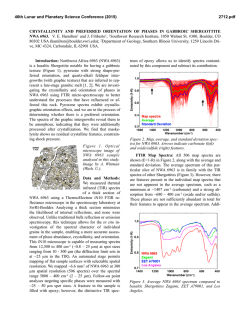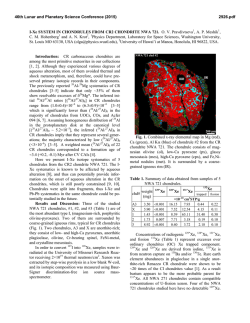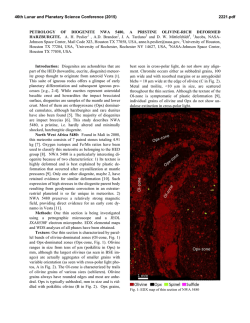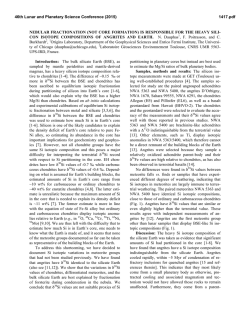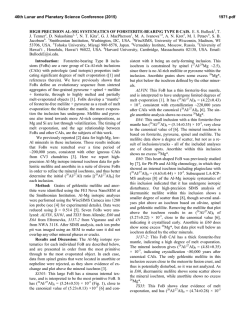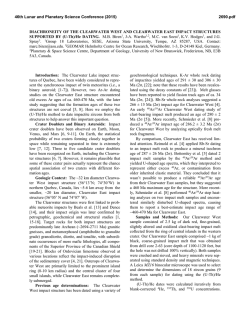
documento 455262
46th Lunar and Planetary Science Conference (2015) 2742.pdf 40 1 AR/39AR SYSTEMATICS OF SHERGOTTITE NWA 4468. W. S. Cassata1 and L. E. Borg1 Lawrence Livermore National Laboratory, 7000 East Avenue (L-231), Livermore, CA 94550 ([email protected]). Introduction: 40Ar/39Ar ages obtained from Shergottites are often significantly older than ages obtained by other radioisotopic methods (e.g., Sm-Nd and RbSr; [1]). Excess 40Ar (40Are) is generally cited as the cause of old apparent ages (e.g., [1, 2]), although in some instances samples yield well-defined isochrons requiring 40Are and 40K to be approximately co-located such that a uniform (40Ar*+40Are)/39Ar ratio is obtained during step-wise degassing (e.g., NWA 2975; [3]). Anomalously old isochron ages can also be obtained if inaccurate corrections for cosmogenic 36Ar (36Arcos) are applied. Here Ar isotope data from NWA 4468 are reported and used to illustrate the sensitivity of some Shergottite 40Ar/39Ar isochron ages to the 36Arcos correction. In this instance, applying corrections based on the minimum 36Ar/37Ar ratio or the average 38Arcos/37Ar ratio of the irradiated sample yields an erroneous crystallization age, which is due to the concomitant degassing of chlorine-derived 38Ar (38ArCl) produced during sample irradiation. Applying 36Arcos corrections based on the exposure age determined from an un-irradiated aliquot of NWA 4468 (1.8 ± 0.1 Ma) yields an isochron age (188 ± 8 Ma) that is indistinguishable from Lu-Hf, Rb-Sr, and Sm-Nd ages (179 ± 27 Ma [4], 187 ± 6 Ma [5], and 150 ± 29 Ma [6], respectively). The trapped 40Ar/36Ar ratio inferred from the NWA 4468 inverse isochron is significantly lower than the Martian atmospheric value. Analytical Procedures: Individual fragments of NWA 4468 weighing 3-5 mg were co-irradiated with fluence monitors for 50 hours at the Oregon State University TRIGA reactor in the Cadmium-Lined In-Core Irradiation Tube (CLICIT). Noble gas extractions on irradiated and un-irradiated aliquots were conducted in the Livermore Noble Gas Lab using temperaturecontrolled diode laser-heating following procedures similar to those described in [7]. Released gases were analyzed using a Nu Instruments Noblesse mass spectrometer equipped with six Faraday cup detectors and four ion-counting, discrete dynode multiplier detectors. Total 36Ar signals were corrected for cosmogenic contributions using the following equation: 36 ! P $! 37 Ar $! 36 Ar $ Arcos = T38 # 38 &# &# & " [Ca] %" γ %" 38 Ar %cos , Eq. (1) where T38 is the 38Ar exposure age, P38/[Ca] is the production rate of 38Arcos relative to the Ca concentration [8], γ is the irradiation parameter relating 37ArCa to Ca content [9], and (36Ar/38Ar)cos is 0.65 [10]. P38/[Ca] was calculated on a step-wise basis using the measured Ca/K ratio and 38Arcos production rates from Ca and K of [11]. Results: Figure 1 illustrates 40Ar/39Ar isochron ages and reduced chi-squared fit statistics calculated for a range in assumed exposure ages. The inferred crystallization age of NWA 4468 varies by 100% over a 1 Ma range in assumed exposure age. To obtain an isochron age that is concordant with the crystallization age determined by the Rb-Sr, Sm-Nd, and Lu-Hf systems, an exposure age of ~1.6-1.9 Ma is required. This is considerably younger than the exposure age inferred from both the minimum 36Ar/37Ar ratio (~2.3 Ma) and the average 38Arcos/37Ar ratio (~4.5 Ma) obtained from step-wise degassing of NWA 4468. Applying 36Arcos corrections based on these exposures ages yields Figure 1: Plot of 40Ar/39Ar inverse isochron ages for NWA 4468 as function of the exposure age used to correct total 36Ar abundances. The reduced chi-squared statistic reflects the goodness of fit. The 1σ error on the best-fit exposure age is estimated from values +1.2 units above the minimum in χν2. Using the exposure age obtained from an un-irradiated aliquot of NWA 4468 (~1.8 Ma; solid gray line) to correct for 36Arcos reproduces the Rb-Sr age (187 Ma; solid blue line; [5]) and lies within the 1σ error envelope of the best-fit model solution. 46th Lunar and Planetary Science Conference (2015) anomalously old crystallization ages and excessively scattered isochrons (Fig. 1). The exposure age spectrum calculated based on apparent 38Arcos/37Ar ratios (no chlorine corrections; not shown) is highly variable, which indicates that 38ArCl produced during sample irradiation is released throughout the degassing experiment. This 38ArCl is likely associated with apatite present in NWA 4468 and possibly melt inclusions or alteration minerals. Although the individual step 38 Ar/36Ar ratios generally do not exceed the nominal cosmogenic ratio of 1.54 [10], the exposure age inferred from the irradiated aliquot is meaningless. The 38 Arcos exposure age calculated from an un-irradiated aliquot of NWA 4468 is 1.8 ± 0.1 Ma. Applying corrections to 36Arcos using this exposure age yields a 40 Ar/39Ar inverse isochron age of 188 ± 8 Ma, which is indistinguishable from the Rb-Sr age of 187 ± 6 Ma [5]. Discussion: The 40Ar/39Ar age of NWA 4468, and other Shergottites, is highly dependent on corrections applied for 36Arcos (Fig. 1). Nakhlite 40Ar/39Ar ages are also susceptible to isochron rotation due to erroneous 36 Arcos corrections, although the relative magnitude of the effect is generally less significant given their antiquity. It is not possible to calculate an exposure for NWA 4468 from irradiated fragments due to pervasive contamination by 38ArCl. On-going analyses of He, Ne, Ar, Kr, and Xe in un-irradiated aliquots will be used to further refine the 40Ar/39Ar age and 38Arcos exposure age of NWA 4468. Figure 2: Inverse isochron diagram for NWA 4468 calculated using an exposure age of 1.8 Ma to correct total 36 Ar abundances. The felsic (red) and mafic (blue) derived gas extractions, distinguished by their K/Ca ratios and outgassing temperature, appear to have equilibrated with different noble gas reservoirs. 2742.pdf Figure 2 depicts an inverse isochron diagram for NWA 4468 calculated using an exposure age of 1.8 Ma to correct for 36Arcos. The trapped component defined primarily by maskelynite-derived gas (red data points in Figure 2) has a 40Ar/36Ar ratio of 990 ± 17. This ratio is relatively insensitive to the exposure age of the sample, varying by only ± 50 over the range in exposure ages shown in Figure 1. The 40Ar/36Ar ratio of the trapped component is significantly lower than the Martian atmospheric value, and likely represents an upper mantle or crustal component. On-going analyses of Xe isotopes will provide further insight into the nature of the trapped component in NWA 4468. High temperature extractions associated with Ar released from mafic minerals (blue data points in Figure 2) define an isochron with an age of 1515 ± 386 Ma (MSWD = 3.9; trapped 40Ar/36Ar = 159 ± 22). This age may reflect an excess Ar component or may be indicative of a xenocrystic origin of some mafic minerals. Future work will focus on applying the step-wise cosmogenic correction approach described above to other Shergottites in an effort to resolves age discrepancies and obtain high-precision constraints on trapped components. References: [1] Bogard D. et al. (2009) Meteoritics & Planetary Science, 44, 905-923. [2] Bogard D. and Park J. (2008) Meteoritics & Planetary Science, 43, 1113-1126. [3] Lindsay F.N. et al. (2013) LPSC XXXXIV, Abstract #2911. [4] Lapen T.J. et al. (2009) LPSC XXXX, Abstract #2376. [5] Marks N.E. et al. (2010) LPSC XXXXI, Abstract #2064. [6] Borg L.E. et al., (2008) LPSC XXXIX, Abstract #1851. [7] Cassata W.S. et al. (2010) Geochimica et Cosmochimica Acta, 74, 6900–6920. [8] Turner G. et al. (1997) Geochimica et Cosmochimica Acta, 61, 3835-3850. [9] Levine J. et al. (2007) Geochimica et Cosmochimica Acta, 71, 1624-1635. [10] Wieler R. (2002) Reviews in Mineralogy and Geochemistry, 47, 125-170. [11] Eugster O. and Michel (1995) Geochimica et Cosmochimica Acta, 59, 177-199. Acknowledgments: This work performed under the auspices of the U.S. Department of Energy by Lawrence Livermore National Laboratory under Contract DE-AC52-07NA27344. Financial support was provided by the NASA Mars Fundamental Research Program (grant NNH14AX56I to W.S.C.).
© Copyright 2025

